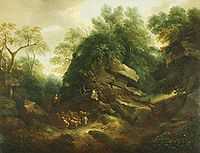Thomas Barker (painter)
| Thomas Barker | |
|---|---|
 | |
| Born |
1769 Pontypool, Wales |
| Died |
1847 Bath, England |
| Nationality | Welsh |
Thomas Barker (1769 – 11 December 1847), (known as 'Barker of Bath,') was a British painter of landscape and rural life.
Early life
Barker was born in 1769, at Trosnant near the village of Pontypool, in Monmouthshire.[1] His father, Benjamin Barker, was the son of a barrister, and practiced as an artist, but never attempted more than the portraits of horses. He eventually took up employment as a Japanware decorator.[2]
From an early age Barker showed a remarkable talent for drawing figures and designing landscapes; although he never took a lesson in either drawing or painting and was entirely self-taught. When he was sixteen his family moved to Bath where the patronage of an opulent coach-builder named Spackman, allowed him to follow his talent as an artist. During the first four years he employed himself in copying the works of the old Dutch and Flemish masters. At the age of twenty-one he was sent to Rome, with ample funds to maintain his position there as a gentleman. While there he painted very little, contenting himself with society life.
Life as an artist

Barker was an occasional exhibitor at the Royal Academy and the British Institution for almost fifty years, during which period he exhibited nearly one hundred pictures. He was a prolific artist, and painted a wide range of subjects. Few pictures of the English school are more generally known and appreciated than The Woodman, of which it appears two were painted, both of them from nature, and of life size: the first was sold to Mr. Macklin for 500 guineas; the second, for the same amount, became the property of Lord W. Paulett. In 1821 he painted the Trial of Queen Caroline, which included portraits of many celebrated men; but perhaps the best effort of Barker's pencil skill was the fresco, 30 feet in length, and 12 feet in height, representing The Inroad of the Turks upon Scio, in April, 1822, painted on the wall of his residence, Sion Hill, Bath.
While Barker's talents were in full vigour, no artist of his time had a greater hold on popular favour; his pictures of The Woodman, Old Tom (painted before he was seventeen years of age), and gipsy groups and rustic figures, were copied onto almost every possible material: Staffordshire pottery, Worcester china, Manchester cottons, and Glasgow linens. At one time he amassed considerable property by the sale of his works, and spent a large sum in building a mansion for his residence, enriching it with sculpture and other works of art. He died at Bath in 1847.
Works
There are six paintings by Barker in the Tate Gallery,[3] including A Woodman and his Dog in a Storm (originally presented to the National Gallery in 1868)[4] and several landscapes.[3]
Three of Barker's paintings, Italian Landscape 1808, Landscape with a Waterfall and Landscape with Cattle are in Wolverhampton Art Gallery.[5]
Family
As well as Thomas Barker, the Barker family produced several artists of note. As well as his father's ability, Thomas' younger brother Benjamin Barker II (1776–1838) was also a talented artist known for his landscape work. Benjamin II exhibited at the Royal Academy and many of his works were engraved by Thales Fielding in aquatint. Barker's son, Thomas Jones Barker (1815–1882), followed his father and uncle into painting, studying at the studio of Horace Vernet in Paris. Many of Jones Barker's works were of a military nature, including Lord Clive's relief of Lucknow and The Allied generals before Sebastopol.[1]
References
- ↑ 1.0 1.1 Rees, Thomas Mardy. "Biography of Thomas Barker". National Library of Wales. Retrieved 8 June 2012.
- ↑ Faces of Wales National Museum Wales
- ↑ 3.0 3.1 "Thomas Barker of Bath". The Tate Gallery. Retrieved 5 July 2012.
- ↑ "A Woodman and his Dog in a Storm". The Tate Gallery. Retrieved 5 July 2012.
- ↑ Oil paintings in public ownership in Staffordshire. London: The Public Catalogue Foundation. 2007. p. 238. ISBN 1-904931-34-0.
|first1=missing|last1=in Authors list (help)
- 139 Paintings by Thomas Barker at the BBC Your Paintings site
This article incorporates text from the article "BARKER, Thomas" in Bryan's Dictionary of Painters and Engravers by Michael Bryan, edited by Robert Edmund Graves and Sir Walter Armstrong, an 1886–1889 publication now in the public domain.
|